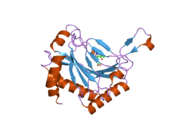EGLN1
Ensembl | |||||||||
|---|---|---|---|---|---|---|---|---|---|
| UniProt | |||||||||
| RefSeq (mRNA) | |||||||||
| RefSeq (protein) | |||||||||
| Location (UCSC) | Chr 1: 231.36 – 231.42 Mb | Chr 8: 125.64 – 125.68 Mb | |||||||
| PubMed search | [3] | [4] | |||||||
| View/Edit Human | View/Edit Mouse |
Hypoxia-inducible factor prolyl hydroxylase 2 (HIF-PH2), or prolyl hydroxylase domain-containing protein 2 (PHD2), is an enzyme encoded by the EGLN1
The hypoxia response
Structure

PHD2 is a 46-kDa enzyme that consists of an
PHD2 catalyses the hydroxylation of two sites on HIF-α, which are termed the N-terminal oxygen dependent degradation domain (residues 395-413, NODD) and the C-terminal oxygen dependent degradation domain (residues 556-574, CODD).
The enzyme has a high affinity for iron(II) and
Mechanism
The enzyme incorporates one oxygen atom from dioxygen into the hydroxylated product, and one oxygen atom into the

Biological role and disease relevance
PHD2 is the primary regulator of HIF-1α
However, although it would seem that PHD2 downregulates HIF-1α and thus also tumorigenesis, there have been suggestions of paradoxical roles of PHD2 in
Recent
As a therapeutic target
HIF's important role as a
References
- ^ a b c GRCh38: Ensembl release 89: ENSG00000135766 – Ensembl, May 2017
- ^ a b c GRCm38: Ensembl release 89: ENSMUSG00000031987 – Ensembl, May 2017
- ^ "Human PubMed Reference:". National Center for Biotechnology Information, U.S. National Library of Medicine.
- ^ "Mouse PubMed Reference:". National Center for Biotechnology Information, U.S. National Library of Medicine.
- PMID 11056053.
- PMID 11574160.
- ^ "Entrez Gene: EGLN1 egl nine homolog 1 (C. elegans)".
- ^ PMID 12912907.
- ^ PMID 15581484.
- ^ PMID 16782814.
- ^ PMID 19604478.
- PMID 20695530.
- S2CID 52078684.
- PMID 18063574.
- ^ PMID 27561929.
- .
- PMID 29899950.
- PMID 16880998.
- PMID 16952279.
- PMID 12788921.
- PMID 12039559.
- PMID 29522057.
- PMID 21436457.
- S2CID 24482234.
- PMID 22420978.
- PMID 22236543.
- S2CID 45471238.
- PMID 22804960.
- PMID 22687491.
- PMID 26147748.
- PMID 21665470.
- S2CID 235460239.
- PMID 12925778.
- PMID 17060326.
Further reading
- Semenza GL (2001). "HIF-1, O(2), and the 3 PHDs: how animal cells signal hypoxia to the nucleus". Cell. 107 (1): 1–3. S2CID 14922615.
- Wax SD, Tsao L, Lieb ME, et al. (1996). "SM-20 is a novel 40-kd protein whose expression in the arterial wall is restricted to smooth muscle". Lab. Invest. 74 (4): 797–808. PMID 8606489.
- Taylor MS (2001). "Characterization and comparative analysis of the EGLN gene family". Gene. 275 (1): 125–32. PMID 11574160.
- Epstein AC, Gleadle JM, McNeill LA, et al. (2001). "C. elegans EGL-9 and mammalian homologs define a family of dioxygenases that regulate HIF by prolyl hydroxylation". Cell. 107 (1): 43–54. S2CID 18372306.
- Oehme F, Ellinghaus P, Kolkhof P, et al. (2002). "Overexpression of PH-4, a novel putative proline 4-hydroxylase, modulates activity of hypoxia-inducible transcription factors". Biochem. Biophys. Res. Commun. 296 (2): 343–9. PMID 12163023.
- Ivan M, Haberberger T, Gervasi DC, et al. (2002). "Biochemical purification and pharmacological inhibition of a mammalian prolyl hydroxylase acting on hypoxia-inducible factor". Proc. Natl. Acad. Sci. U.S.A. 99 (21): 13459–64. PMID 12351678.
- Strausberg RL, Feingold EA, Grouse LH, et al. (2003). "Generation and initial analysis of more than 15,000 full-length human and mouse cDNA sequences". Proc. Natl. Acad. Sci. U.S.A. 99 (26): 16899–903. PMID 12477932.
- Metzen E, Berchner-Pfannschmidt U, Stengel P, et al. (2003). "Intracellular localisation of human HIF-1 alpha hydroxylases: implications for oxygen sensing". J. Cell Sci. 116 (Pt 7): 1319–26. PMID 12615973.
- Cioffi CL, Liu XQ, Kosinski PA, et al. (2003). "Differential regulation of HIF-1 alpha prolyl-4-hydroxylase genes by hypoxia in human cardiovascular cells". Biochem. Biophys. Res. Commun. 303 (3): 947–53. PMID 12670503.
- Aprelikova O, Chandramouli GV, Wood M, et al. (2004). "Regulation of HIF prolyl hydroxylases by hypoxia-inducible factors". J. Cell. Biochem. 92 (3): 491–501. S2CID 24455956.
- Appelhoff RJ, Tian YM, Raval RR, et al. (2004). "Differential function of the prolyl hydroxylases PHD1, PHD2, and PHD3 in the regulation of hypoxia-inducible factor". J. Biol. Chem. 279 (37): 38458–65. PMID 15247232.
- Metzen E, Stiehl DP, Doege K, et al. (2006). "Regulation of the prolyl hydroxylase domain protein 2 (phd2/egln-1) gene: identification of a functional hypoxia-responsive element". Biochem. J. 387 (Pt 3): 711–7. PMID 15563275.
- Baek JH, Mahon PC, Oh J, et al. (2005). "OS-9 interacts with hypoxia-inducible factor 1alpha and prolyl hydroxylases to promote oxygen-dependent degradation of HIF-1alpha". Mol. Cell. 17 (4): 503–12. PMID 15721254.
- Ozer A, Wu LC, Bruick RK (2005). "The candidate tumor suppressor ING4 represses activation of the hypoxia inducible factor (HIF)". Proc. Natl. Acad. Sci. U.S.A. 102 (21): 7481–6. PMID 15897452.
- Choi KO, Lee T, Lee N, et al. (2006). "Inhibition of the catalytic activity of hypoxia-inducible factor-1alpha-prolyl-hydroxylase 2 by a MYND-type zinc finger". Mol. Pharmacol. 68 (6): 1803–9. S2CID 6673747.
- To KK, Huang LE (2006). "SUPPRESSION OF HIF-1α TRANSCRIPTIONAL ACTIVITY BY THE HIF PROLYL HYDROXYLASE EGLN1". J. Biol. Chem. 280 (45): 38102–7. PMID 16157596.
- Kato H, Inoue T, Asanoma K, et al. (2006). "Induction of human endometrial cancer cell senescence through modulation of HIF-1alpha activity by EGLN1". Int. J. Cancer. 118 (5): 1144–53. PMID 16161047.




